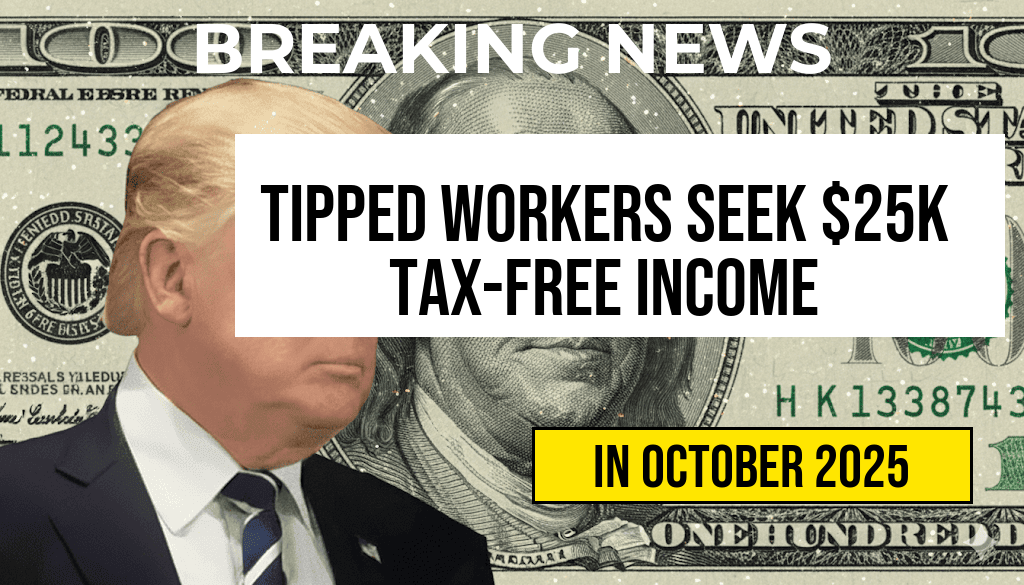Lower-Income Tipped Workers Face Financial Crossroads Amid Proposed Tax Changes
Many tipped workers across the United States are grappling with a complex financial landscape as recent proposals threaten to reshape their earning potential. While some are advocating for a pathway to earn up to $25,000 tax-free annually through expanded tax credits, others face the prospect of losing more than $1,000 in Earned Income Tax Credit (EITC) benefits. The debate centers on balancing fair compensation for service industry employees with broader tax policy reforms aimed at reducing reliance on government assistance programs.
For tipped workers—such as waitstaff, bartenders, and salon professionals—this situation underscores the delicate interplay between wage structures, tax incentives, and social safety nets. As policymakers consider modifications to tax credits and income thresholds, those on the front lines worry about how these changes could impact their bottom line, especially amid rising living costs and unpredictable income streams.
Understanding the Proposed Changes and Their Impacts
The core of the ongoing debate involves the structure of the Earned Income Tax Credit (EITC) and its role in supporting low- to moderate-income workers. Currently, the EITC provides substantial benefits to workers who earn below certain thresholds, incentivizing employment and supplementing wages. However, recent legislative proposals aim to tighten eligibility criteria, phase out benefits at higher income levels, or modify credit amounts, which could disproportionately affect tipped workers.
What Tipped Workers Stand to Gain
Supporters of expanding tax credits argue that targeted increases could allow tipped employees to earn up to $25,000 tax-free annually, shielding more income from taxation and reducing reliance on social safety nets. This approach aims to recognize the variability of income in the service industry, where tips often constitute a significant part of overall earnings.
According to advocates, establishing a higher tax-free threshold would:
- Provide financial stability for workers with fluctuating incomes
- Encourage employment and reduce poverty levels
- Streamline tax filing processes by increasing the standard deduction for tipped workers
Some policymakers suggest that such measures could serve as a lifeline for millions of workers whose earnings are heavily dependent on tips, especially in regions with high living costs.
Potential Losses in EITC Benefits
Conversely, critics warn that tightening eligibility or reducing credit amounts could result in more than $1,000 loss in benefits annually for many qualifying workers. For individuals already earning near the eligibility thresholds, even modest reductions can substantially decrease take-home pay.
Data from recent studies indicates that roughly 30% of tipped workers could see their EITC benefits diminish under proposed reforms, intensifying financial strain. For many, this translates into fewer resources for essentials such as rent, healthcare, and transportation, exacerbating economic insecurity.
Financial Realities for Tipped Workers
The income of tipped workers varies widely, with some earning modest wages supplemented by tips, while others rely heavily on gratuities for a substantial portion of their earnings. The federal tipped minimum wage currently stands at $2.13 per hour, though many states set higher rates, complicating the picture further.
The seasonal and unpredictable nature of tipping income complicates financial planning, especially when policy changes threaten to reduce key support programs.
Case Study: The Restaurant Industry
A recent survey conducted by the National Restaurant Association found that nearly 60% of restaurant workers earn less than $15,000 annually when combining wages and tips. For these workers, the prospect of losing $1,000 or more in EITC benefits would represent a significant portion of their annual income, potentially forcing tough choices between basic necessities.
Policy Perspectives and Future Outlook
Proponents of reform emphasize the need for simplifying tax benefits and promoting wage growth. They argue that targeted tax credits can incentivize employment while reducing dependency on government assistance. Meanwhile, opponents worry that such measures could inadvertently penalize the very workers they aim to help.
The Biden administration’s recent proposals include measures to expand the Child Tax Credit and modify the EITC to better serve low-income workers, but specific provisions concerning tipped workers remain under debate. Stakeholders across the industry continue to lobby for policies that balance fair compensation with fiscal responsibility.
Resources for Workers and Employers
Workers seeking to understand how potential changes could affect their income can visit the IRS EITC page for detailed eligibility criteria and updates. Employers and advocacy groups are also working to provide guidance on navigating potential tax reforms and maximizing available benefits.
Summary Table: Potential Outcomes for Tipped Workers
| Scenario | Potential Income Change | Key Considerations |
|---|---|---|
| Expanded $25,000 tax-free threshold | Increase in net income for many workers | Requires eligibility adjustments; may benefit higher earners |
| Reduction or elimination of EITC benefits | Possible loss of $1,000+ annually | Could deepen financial hardship for low-income workers |
As discussions continue, tipped workers and advocacy groups alike emphasize the importance of policies that recognize the realities of their earnings. Striking a balance between fiscal responsibility and fair compensation remains a challenge for lawmakers aiming to support economic stability in the service industry.
For further insights into this evolving issue, consult resources like the Forbes coverage on labor policy and the Wikipedia page on the EITC.
Frequently Asked Questions
What is the main concern for tipped workers regarding the Earned Income Tax Credit (EITC)?
Tipped workers are worried about potentially losing more than $1,000 in EITC benefits due to recent changes or income adjustments, which could significantly impact their tax refunds.
How are tipped workers aiming to achieve a $25,000 tax-free income?
Many tipped workers are seeking strategies such as maximizing deductions, utilizing tax credits, and ensuring proper reporting of tips to legally increase their tax-free income up to $25,000.
What recent changes have affected EITC benefits for tipped workers?
Recent policy adjustments and income thresholds have limited EITC eligibility for some tipped workers, risking a potential loss of over $1,000 in benefits and prompting concerns about tax fairness.
What steps can tipped workers take to protect their tax benefits?
Tipped workers should regularly review their income reports, consult with tax professionals, and ensure accurate tip reporting to maximize their tax credits and minimize benefit losses.
Who can tipped workers contact for assistance with tax and benefits issues?
Workers can reach out to tax advisors, IRS resources, or local labor agencies for guidance on tax planning and to better understand how to optimize EITC and other benefits.









